A Comprehensive Guide to Cat Food, Including Homemade Recipes
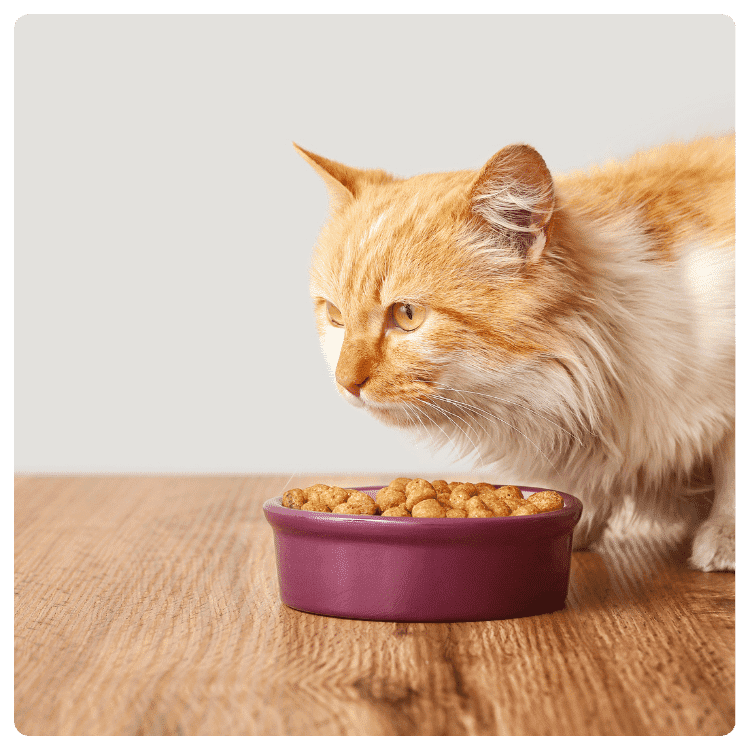
Proper nutrition is crucial for the health and well-being of your feline friend. Just like humans, cats require a balanced diet to maintain their energy levels, support their immune system, and ensure they lead long healthy lives. Understanding what constitutes good nutrition for cats can help prevent a range of health issues, from obesity to kidney disease, and can enhance their overall quality of life.
The purpose of this guide is to provide you with comprehensive insights into cat nutrition. Whether you’re a new cat owner or an experienced feline enthusiast, this guide will help you make informed decisions about your cat’s diet. You’ll learn about the essential nutrients your cat needs, the benefits of different types of cat food, how to read pet food labels and tips for managing special dietary needs. By the end of this guide, you’ll be well-equipped to ensure your cat receives the optimal nutrition they deserve.
Understanding Cat Nutritional Needs
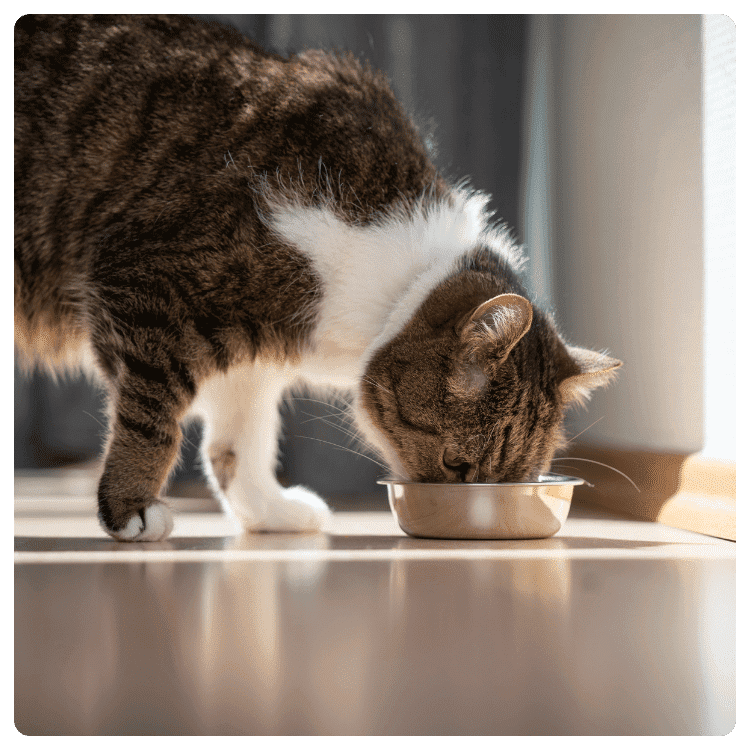
Cats, as obligate carnivores, have unique nutritional needs that differ significantly from those of omnivores like humans and dogs. Understanding these requirements is crucial for ensuring your cat’s health and vitality at every stage of life. Here’s a breakdown of the essential nutrients your cat needs:
Proteins
Proteins are the cornerstone of a cat’s diet. They provide essential amino acids, such as taurine, that cats cannot synthesize in sufficient quantities on their own. High-quality animal-based proteins are vital for maintaining muscle mass, supporting a healthy immune system, and ensuring proper growth and development, especially in kittens.
Fats
Fats are a primary energy source for cats and are necessary for the absorption of fat-soluble vitamins (A, D, E, and K). They also support healthy skin and a shiny coat. Essential fatty acids, like omega-3 and omega-6, play a crucial role in inflammation control and overall cellular health.
Vitamins
Cats require a range of vitamins to support various bodily functions:
- Vitamin A: Important for vision, immune function, and skin health.
- Vitamin D: Essential for calcium absorption and bone health.
- B Vitamins: Critical for energy metabolism and nervous system function. Cats cannot convert beta-carotene to vitamin A, as some animals can, so they must obtain preformed vitamin A from animal sources.
Minerals
Minerals are necessary for numerous physiological functions:
- Calcium and Phosphorus: Vital for bone health.
- Magnesium: Important for muscle and nerve function.
- Iron: Essential for oxygen transport in the blood.
- Potassium and Sodium: Key for maintaining fluid balance and cellular function.
Life Stage Nutrition
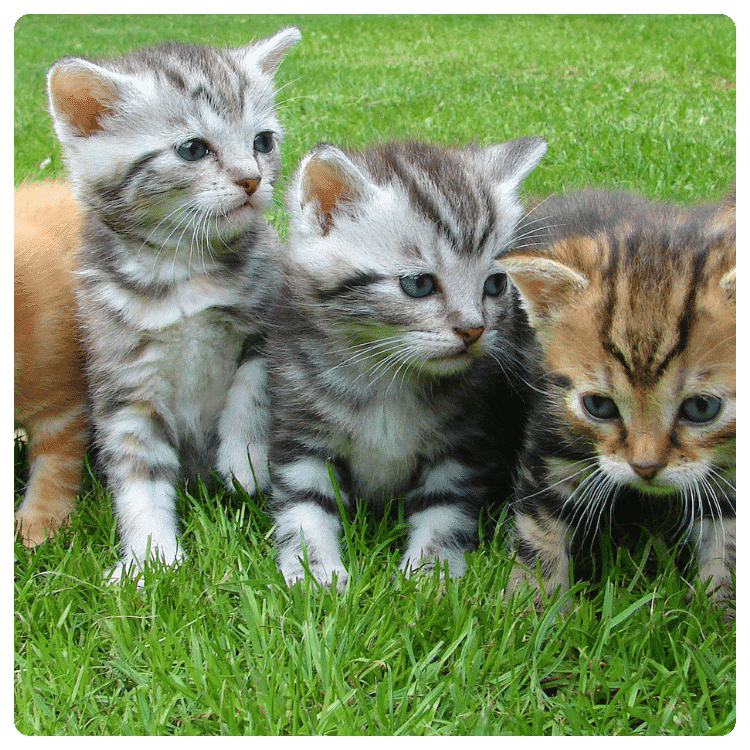
Kittens
Kittens require more protein, fat, and calories than adult cats to support their rapid growth and high energy levels. They also need higher amounts of certain vitamins and minerals to ensure proper bone development and overall health.
Adults
Adult cats need a balanced diet that maintains their weight and supports their lifestyle, whether they are active or sedentary. The focus should be on maintaining lean body mass and preventing obesity.
Seniors
Senior cats often have different nutritional needs due to changes in metabolism and potential health issues. They may benefit from diets that are lower in calories but still rich in high-quality protein to maintain muscle mass. Additionally, older cats might need increased levels of certain nutrients, like antioxidants, to support aging organs and immune function.
The Importance of a Balanced Diet

A balanced diet ensures that your cat receives all the essential nutrients in the right proportions. This balance helps prevent deficiencies and excesses that can lead to health problems. For instance, an imbalance of calcium and phosphorus can affect bone health, while insufficient taurine can lead to heart and eye issues.
By understanding and meeting your cat’s nutritional needs, you can help them lead a healthy, active, and happy life at every stage.
Types of Cat Food
When it comes to feeding your cat, there are various types of food to choose from, each with its advantages and disadvantages. Understanding these can help you make an informed decision that best suits your cat’s needs and preferences.
Wet Cat Food
Pros:
- High Moisture Content: Wet cat food typically contains about 75-80% water, which helps keep your cat hydrated, especially important for cats that don’t drink much water.
- Palatability: Wet food tends to be more flavorful and aromatic, making it more appealing to picky eaters.
- Nutrient Density: Often richer in protein and lower in carbohydrates, aligning well with a cat’s natural diet.
Cons:
- Cost: Wet food is generally more expensive than dry food.
- Storage: Once opened, it must be refrigerated and used within a few days to prevent spoilage.
- Dental Health: Wet food doesn’t provide the same teeth-cleaning benefits as dry food, potentially leading to dental issues if dental care is neglected.
Dry Cat Food
Pros:
- Convenience: Dry food is easy to store, doesn’t require refrigeration, and can be left out for cats to graze on throughout the day.
- Cost-Effective: Generally less expensive than wet food.
- Dental Benefits: The crunchy texture can help reduce plaque and tartar buildup on teeth.
Cons:
- Low Moisture Content: Dry food contains about 10% water, which may not provide sufficient hydration, especially for cats prone to urinary issues.
- Palatability: May be less appealing to some cats compared to the rich flavors and textures of wet food.
- Carbohydrate Content: Often higher in carbohydrates, which are less suited to a cat’s natural dietary needs.
Semi-Moist Cat Food
Pros:
- Convenience: Easier to store than wet food and doesn’t require refrigeration.
- Palatability: Typically more palatable than dry food due to higher moisture content and added flavors.
Cons:
- Preservatives and Additives: Often contains more preservatives, artificial colors, and flavors.
- Nutritional Value: Can be less nutritionally balanced than high-quality wet or dry foods.
Raw Cat Food
Pros:
- Natural Diet: Mimics a cat’s natural diet, which can lead to better overall health and vitality.
- High Nutrient Content: Often very high in protein and nutrients since it is minimally processed.
Cons:
- Preparation and Storage: Requires careful handling and storage to prevent bacterial contamination and spoilage.
- Cost and Availability: These can be more expensive and harder to find than commercial wet or dry foods.
- Health Risks: Potential risk of pathogens like Salmonella and E. coli if not handled properly.
Choosing the Right Food for Your Cat
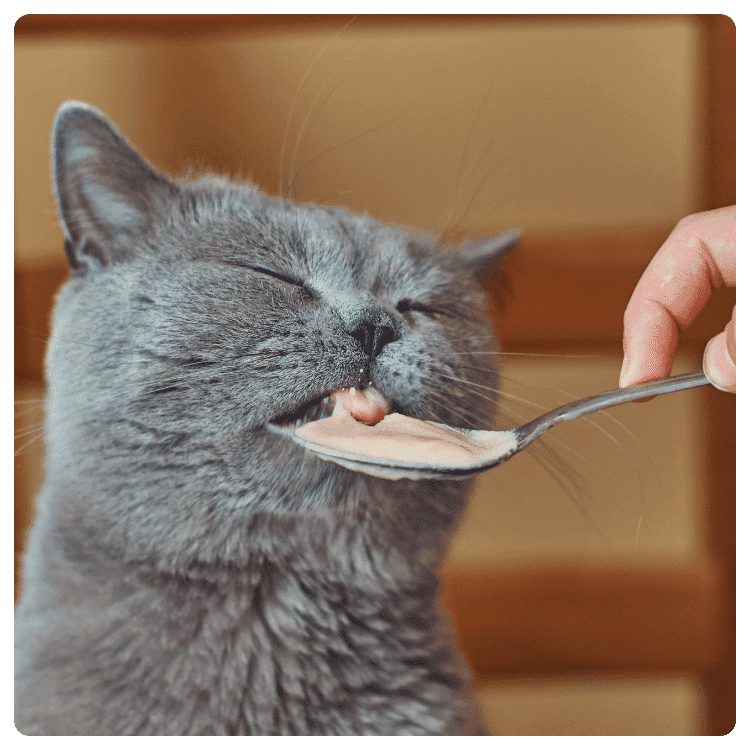
When deciding between wet, dry, semi-moist, and raw cat foods, consider your cat’s individual needs, preferences, and health conditions. Some cats benefit from a combination of wet and dry foods to balance hydration and dental health. Consulting with your veterinarian can also provide guidance tailored to your cat’s specific nutritional requirements.
How to Read Cat Food Labels
Understanding cat food labels is crucial for ensuring your feline friend gets the best nutrition possible. Here’s a comprehensive guide to help you decode these labels and make informed choices.
1) Ingredient Lists
The ingredient list on cat food packaging is a key component in determining the quality of the food.
2) How to Interpret:
- Order of Ingredients: Ingredients are listed by weight, with the heaviest listed first. High-quality cat food should list a specific meat (like chicken, beef, or salmon) as the first ingredient.
- Named Ingredients: Look for specific names (e.g., “chicken” or “beef”) rather than generic terms (e.g., “meat” or “animal by-products”).
- By-Products and Fillers: While some by-products (like organ meats) can be nutritious, avoid foods with a high content of by-products and fillers like corn, wheat, and soy, which offer little nutritional value.
3) What to Look For:
- High-Quality Protein: The primary ingredient should be an animal protein source.
- Natural Ingredients: Foods with natural preservatives (like tocopherols) and fewer artificial additives are generally preferable.
- Essential Nutrients: Ensure the food contains taurine, an essential amino acid for cats, and other necessary vitamins and minerals.
4) What to Avoid:
- Artificial Preservatives, Colors, and Flavors: Ingredients like BHA, BHT, and ethoxyquin should be avoided.
- Excessive Fillers: Foods with high amounts of grains and non-nutritive fillers can lead to weight gain and digestive issues.
5) Nutritional Information
Cat food labels also include a guaranteed analysis of nutrient content and a nutritional adequacy statement.
6) Guaranteed Analysis:
- Crude Protein: Indicates the minimum percentage of protein in the food. Cats need a high-protein diet, so look for higher percentages.
- Crude Fat: Shows the minimum percentage of fat. It is essential for energy, but the right balance is crucial.
- Crude Fiber: Lists the maximum percentage of fiber. Too much fiber can reduce nutrient absorption.
- Moisture: Indicates the water content. Higher moisture is beneficial for hydration, especially in wet foods.
7) Nutritional Adequacy Statement:
- AAFCO Statement: Look for a statement from the Association of American Feed Control Officials (AAFCO) indicating the food is “complete and balanced” for a specific life stage (growth, maintenance, etc.). This means the food meets minimum nutritional requirements.
8) Feeding Guidelines:
- Portion Recommendations: These are usually based on the cat’s weight and life stage. Adjust portions based on your cat’s activity level and health.
9) Key Points to Remember
- Complete and Balanced: Ensure the food is labeled as “complete and balanced” for your cat’s life stage.
- Life Stage Appropriateness: Choose food that matches your cat’s age, whether kitten, adult, or senior.
- Specific Animal Proteins: Prefer foods that specify the animal protein source.
- Avoid Unnecessary Additives: Steer clear of foods with artificial preservatives, colors, and excessive fillers.
By carefully reading and interpreting cat food labels, you can make better choices that support your cat’s health and well-being. Always consult with your veterinarian if you have any doubts or specific dietary concerns regarding your cat’s nutrition.
Homemade Cat Food Recipes
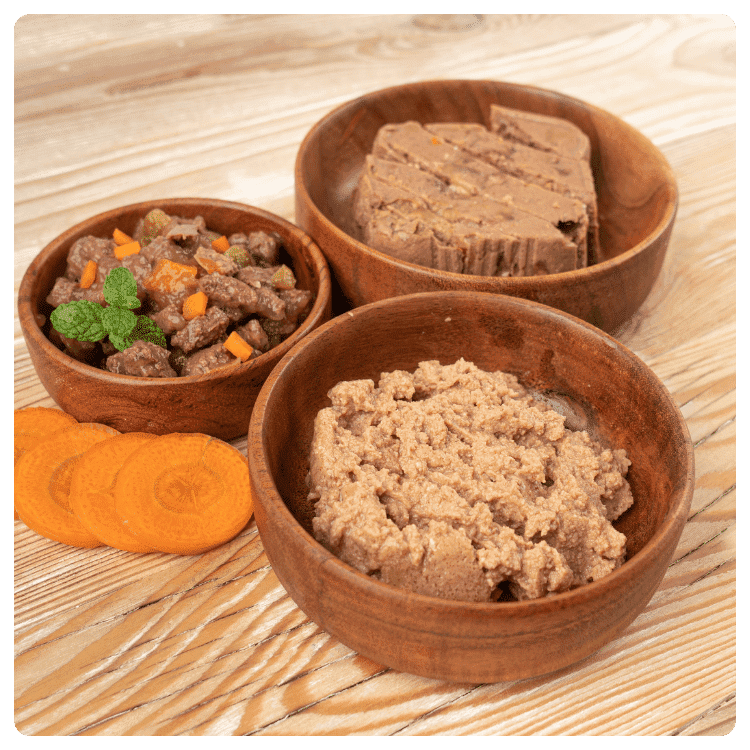
Preparing homemade cat food in India can be a delightful way to ensure your feline companion receives wholesome nutrition. Here are some simple and nutritious recipes using ingredients commonly found in Indian households:
Recipe 1: Chicken and Rice Delight
Ingredients:
- 1 cup cooked chicken (boneless and skinless)
- 1/4 cup cooked white rice
- 1/4 cup cooked green peas (mashed)
- 1 tablespoon coconut oil (for healthy fats)
- 1/4 teaspoon taurine supplement
Instructions:
- Cook the chicken thoroughly and chop it into small pieces.
- Mix the cooked chicken with the rice and mashed green peas.
- Add the coconut oil and taurine supplement, stirring until well combined.
- Serve at room temperature. Store leftovers in the refrigerator for up to 3 days.
Recipe 2: Fish and Lentil Delight
Ingredients:
- 1 cup cooked fish (boneless and skinless)
- 1/2 cup cooked lentils (mashed)
- 1/4 cup cooked carrots (finely chopped)
- 1 tablespoon ghee (clarified butter)
- 1/4 teaspoon taurine supplement
Instructions:
- Cook the fish thoroughly and flake it into small pieces.
- Mix the cooked fish with the mashed lentils and finely chopped carrots.
- Add the ghee and taurine supplement, stirring until well combined.
- Serve at room temperature. Store leftovers in the refrigerator for up to 3 days.
Recipe 3: Paneer and Vegetable Medley
Ingredients:
- 1/2 cup paneer (Indian cottage cheese), crumbled
- 1/2 cup cooked mixed vegetables (such as carrots, peas, and beans)
- 1/4 cup cooked brown rice
- 1 tablespoon olive oil
- 1/4 teaspoon taurine supplement
Instructions:
- Crumble the paneer into small pieces.
- Mix the crumbled paneer with the cooked mixed vegetables and brown rice.
- Add the olive oil and taurine supplement, stirring until well combined.
- Serve at room temperature. Store leftovers in the refrigerator for up to 3 days.
Tips for Preparing Homemade Cat Food
- Consult Your Veterinarian: Before switching to homemade cat food, consult your veterinarian to ensure it meets your cat’s specific nutritional needs.
- High-Quality Ingredients: Use fresh, high-quality ingredients, preferably organic, to ensure your cat receives the best nutrition.
- Avoid Harmful Spices: Avoid using spices such as onions, garlic, and chili powder, as they can be harmful to cats.
- Variety: Offer a variety of recipes to provide a balanced diet and prevent boredom.
- Supplements: Consider adding a multivitamin or mineral supplement to ensure your cat receives all essential nutrients.
- Portion Control: Monitor portion sizes to prevent overfeeding and maintain a healthy weight for your cat.
By preparing homemade cat food with these recipes and tips, you can provide your cat with delicious, nutritious meals tailored to their dietary needs while incorporating flavors and ingredients commonly found in India.
Common Cat Food Myths and Facts
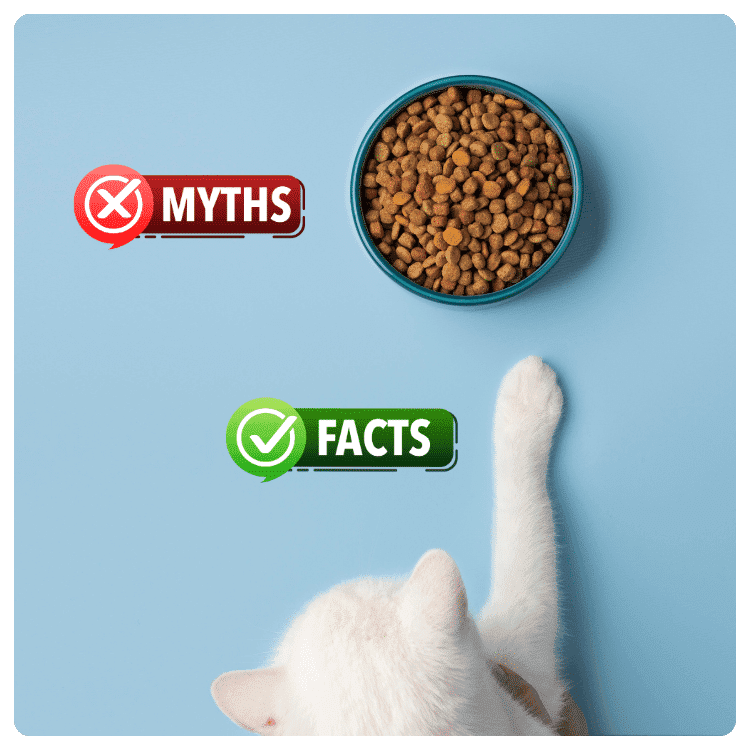
Misinformation about cat food abounds, leading to confusion among cat owners. Let’s debunk some of the most prevalent myths and provide factual information based on science to help you make informed decisions about your cat’s nutrition.
Myth 1: “All Dry Food is Bad for Cats.”
Fact: While wet food offers higher moisture content, not all dry food is inherently bad for cats. High-quality dry cat food can provide a balanced diet, especially with proper hydration and regular dental care. Look for dry foods with high protein content and minimal fillers.
Myth 2: “Raw Meat Diets Are Best for Cats.”
Fact: While some advocate for raw meat diets, they come with risks. Improperly handled raw meat can contain harmful bacteria, such as Salmonella and E. coli, which can make cats and humans sick. Additionally, homemade raw diets may lack essential nutrients unless carefully formulated and supplemented. Consult with a veterinarian before transitioning your cat to a raw diet.
Myth 3: “Cats Should Only Eat Fish-Based Food.”
Fact: While cats may enjoy fish-based foods, they shouldn’t comprise the entirety of their diet. Fish alone can lead to nutritional imbalances, such as excessive phosphorus and magnesium levels, which may contribute to urinary tract issues. Variety is key to ensuring your cat receives a balanced diet, so rotate protein sources and include poultry, meat, and fish in moderation.
Myth 4: “Grain-Free Diets Are Healthier for Cats.”
Fact: While some cats may benefit from grain-free diets due to food allergies or sensitivities, grains are not inherently harmful to cats. Grains can provide valuable nutrients and act as a source of energy. The focus should be on the quality of ingredients and ensuring the diet meets your cat’s specific nutritional needs, rather than simply avoiding grains.
Myth 5: “Cats Should Eat Only Organic Food.”
Fact: While organic cat food may appeal to some owners seeking to minimize exposure to pesticides and synthetic additives, organic certification does not necessarily guarantee superior nutritional quality. Focus on choosing high-quality cat food with natural, wholesome ingredients and consult with your veterinarian to determine the best diet for your cat’s individual needs.
Myth 6: “All Cat Food Labels Are Accurate and Trustworthy.”
Fact: While cat food labels provide valuable information, they may not always be entirely accurate or transparent. Look for reputable brands with transparent manufacturing practices and consult with your veterinarian for guidance on selecting the best food for your cat. Additionally, pay attention to the guaranteed analysis and nutritional adequacy statement on the label to ensure the food meets AAFCO standards.
Popular Cat Food Brands

1) Whiskas: Whiskas offers a variety of wet and dry cat food options suitable for different life stages and preferences. It’s a popular choice among cat owners in India and is readily available in pet stores and online.
Pros: Offers a variety of wet and dry options suitable for different life stages and preferences. Widely available in India. Affordable pricing.
Cons: Some cat owners report that certain formulas may contain fillers and artificial ingredients.
2) Royal Canin: Royal Canin is known for its breed-specific and life-stage-specific formulas tailored to meet cats’ unique nutritional needs. It’s widely available in pet stores and veterinary clinics across India.
Pros: Known for breed-specific and life-stage-specific formulas. High-quality ingredients tailored to meet cats’ unique nutritional needs. Available in pet stores and veterinary clinics.
Cons: Premium pricing compared to other brands. Limited variety in some specific formulas.
3) MeO: MeO is a local brand that provides affordable cat food options in both dry and wet formulations. It’s readily available in pet stores and supermarkets throughout India.
Pros: Affordable cat food options in both dry and wet formulations. Widely available in pet stores and supermarkets throughout India.
Cons: Ingredient quality may vary across products. Limited variety compared to other brands.
4) Drools: Drools offers a range of cat food products, including dry kibble and wet food, with options for various dietary preferences and life stages. It’s easily found in pet stores and online platforms in India.
Pros: Offers a range of cat food products, including dry kibble and wet food, with options for various dietary preferences and life stages. Easily found in pet stores and online platforms in India.
Cons: Some cats may have sensitivity or allergy issues with certain formulas. Ingredient quality may not meet the standards of premium brands.
5) Pedigree: While Pedigree is primarily known for its dog food, it also offers a selection of cat food products, including dry kibble and wet food. It’s widely available in supermarkets and pet stores across India.
Pros: Provides both dry kibble and wet food options for cats. Widely available in supermarkets and pet stores across India.
Cons: Primarily known for dog food, so the variety and quality of cat food options may not be as extensive. Some formulas may contain fillers and by-products.
These brands offer various options of cat food to cater to different cats’ needs, preferences, and budgets. Make sure to choose the one that aligns best with your cat’s dietary requirements and consult with a veterinarian for personalized recommendations.
Conclusion
In conclusion, this comprehensive guide to cat food has provided invaluable insights into the nutritional needs of your feline companion. Proper nutrition is not only essential for your cat’s health and vitality but also contributes to their overall happiness and longevity. By understanding the importance of a balanced diet, decoding cat food labels, exploring different types of cat food, and debunking common myths, you’re empowered to make informed decisions about your cat’s nutrition.
Whether you’re a new cat owner or a seasoned feline enthusiast, prioritizing your cat’s nutrition is paramount. Remember to consult with your veterinarian for personalized advice tailored to your cat’s specific needs and circumstances. With the knowledge gained from this guide, you can ensure that your cat receives the optimal nutrition they deserves, leading to a happy, healthy, and thriving companion for years to come.
Frequently Asked Questions
Q1: How much should I feed my cat?
A: Feeding guidelines vary depending on factors such as age, weight, activity level, and the type of food you’re offering. Generally, it’s recommended to follow the portion recommendations provided on the cat food packaging and adjust as needed based on your cat’s individual needs.
Q2: Can I mix different types of cat food?
A: Yes, mixing different types of cat food can provide variety and help ensure your cat receives a balanced diet. For example, you might mix wet and dry food or rotate between different protein sources. Just be mindful of portion sizes and overall nutritional balance.
Q3: How do I know if my cat has food allergies or sensitivities?
A: Common signs of food allergies or sensitivities in cats include skin issues (such as itching or redness), digestive problems (such as vomiting or diarrhea), and changes in behavior or appetite. If you suspect your cat has food allergies, consult with your veterinarian to determine the best course of action, which may include an elimination diet or allergy testing.
Q4: Is it safe to feed my cat homemade food?
A: Homemade cat food can be safe and nutritious if properly formulated to meet your cat’s nutritional needs. However, it’s essential to consult with your veterinarian to ensure the recipes you’re using provide the right balance of nutrients. Additionally, practice proper food handling and storage to prevent contamination and spoilage.
Q5: How often should I change my cat’s food?
A: Gradually transitioning your cat to a new food is recommended to minimize digestive upset. If you’re switching to a different brand or formula, mix a small amount of the new food with the old food and gradually increase the proportion of the new food over several days to a week. If you’re rotating between different flavors or types of food, you can do so periodically to provide variety.
Q6: Should I give my cat supplements?
A: In most cases, cats can get all the nutrients they need from a balanced diet formulated for their life stage. However, some cats may benefit from supplements, especially if they have specific health issues or dietary deficiencies. Consult with your veterinarian before giving your cat any supplements to ensure they are safe and appropriate.
Q7: How can I encourage my cat to drink more water?
A: Some cats are naturally less inclined to drink water, which can lead to dehydration, especially on a dry food diet. You can encourage your cat to drink more water by providing a clean, fresh water source in a clean bowl, using a cat fountain, offering wet food, or adding water to dry food to increase moisture content.
Q8: Are there any foods that are toxic to cats?
A: Yes, several foods are toxic to cats and should be avoided, including onions, garlic, chocolate, grapes, raisins, alcohol, caffeine, and products containing xylitol (a sweetener). Additionally, certain plants, such as lilies, are toxic to cats if ingested. It’s essential to keep these items out of reach of your cat and be cautious about potential hazards in your home.











































